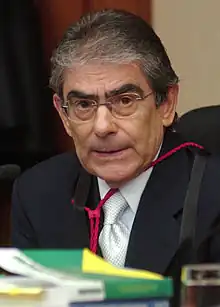Ayres Britto
Carlos Augusto Ayres de Freitas Britto (born November 18, 1942, in Propriá, Sergipe) is a Brazilian jurist and was a Justice of the Supreme Federal Court of Brazil. He was appointed by President Luiz Inácio Lula da Silva and served from June 25, 2003, to November 16, 2012, when he faced mandatory retirement upon reaching the age of 70.[2]
Ayres Britto | |
|---|---|
 | |
| Justice of the Supreme Federal Court | |
| In office June 25, 2003 – November 16, 2012 | |
| Appointed by | Luiz Inácio Lula da Silva |
| Preceded by | Ilmar Galvão |
| Succeeded by | Luís Roberto Barroso |
| 55th President of the Supreme Federal Court | |
| In office April 19, 2012 – November 16, 2012 | |
| Vice President | Joaquim Barbosa |
| Preceded by | Cezar Peluso |
| Succeeded by | Joaquim Barbosa |
| Personal details | |
| Born | November 18, 1942 Propriá, Sergipe, Brazil |
| Spouse | Rita de Cássia Pinheiro Reis de Britto[1] |
| Alma mater | Federal University of Sergipe |
Other judicial positions
| |
He was the chief justice of the Supreme Court of Brazil from April 19, 2012,[1] until his retirement.[2]
Bachelor in Law (1966)by the Federal University of Sergipe, institution of which he would become professor, is master (1982) and doctor (1998) by the Pontifical Catholic University of São Paulo, being guided in the doctorate by Celso Ribeiro Bastos.
Despite his quite short term as Chief Justice of Brazil, he succeeded to conduct many major cases, as well start the trial of the Criminal Action 470 (popularly nicknamed Mensalão), one of the most complex cases in history to be examined by that Court.[2]
He is currently an occasional contributor to O Estado de S. Paulo, a Brazilian newspaper.[3]
References
- Biography of Carlos Ayres Britto - Supremo Tribunal Federal website Archived 2016-06-03 at the Wayback Machine (in Portuguese)
- STF News Archived 2021-02-14 at the Wayback Machine (in Portuguese) Retrieved November 19, 2012.
- Britto, Carlos A. (July 24, 2016). "Culture? Which?" [Cultura? Qual?]. O Estado de S. Paulo (in Portuguese). p. A2. Retrieved July 24, 2016.